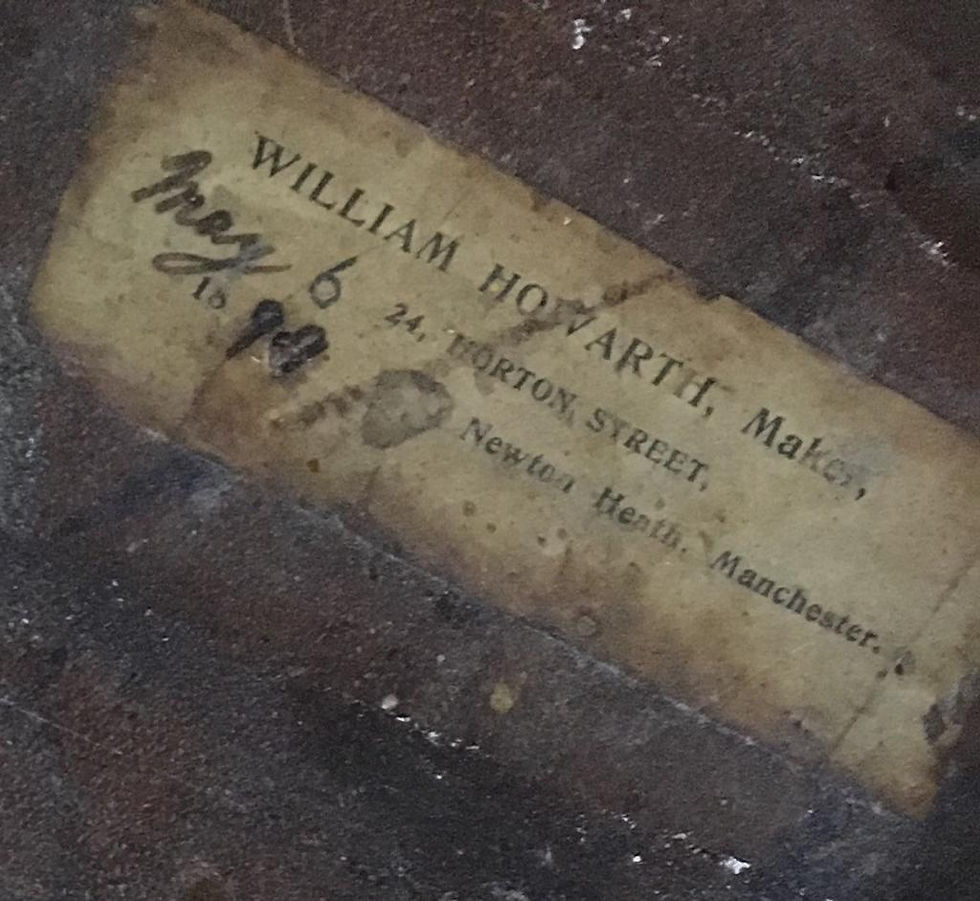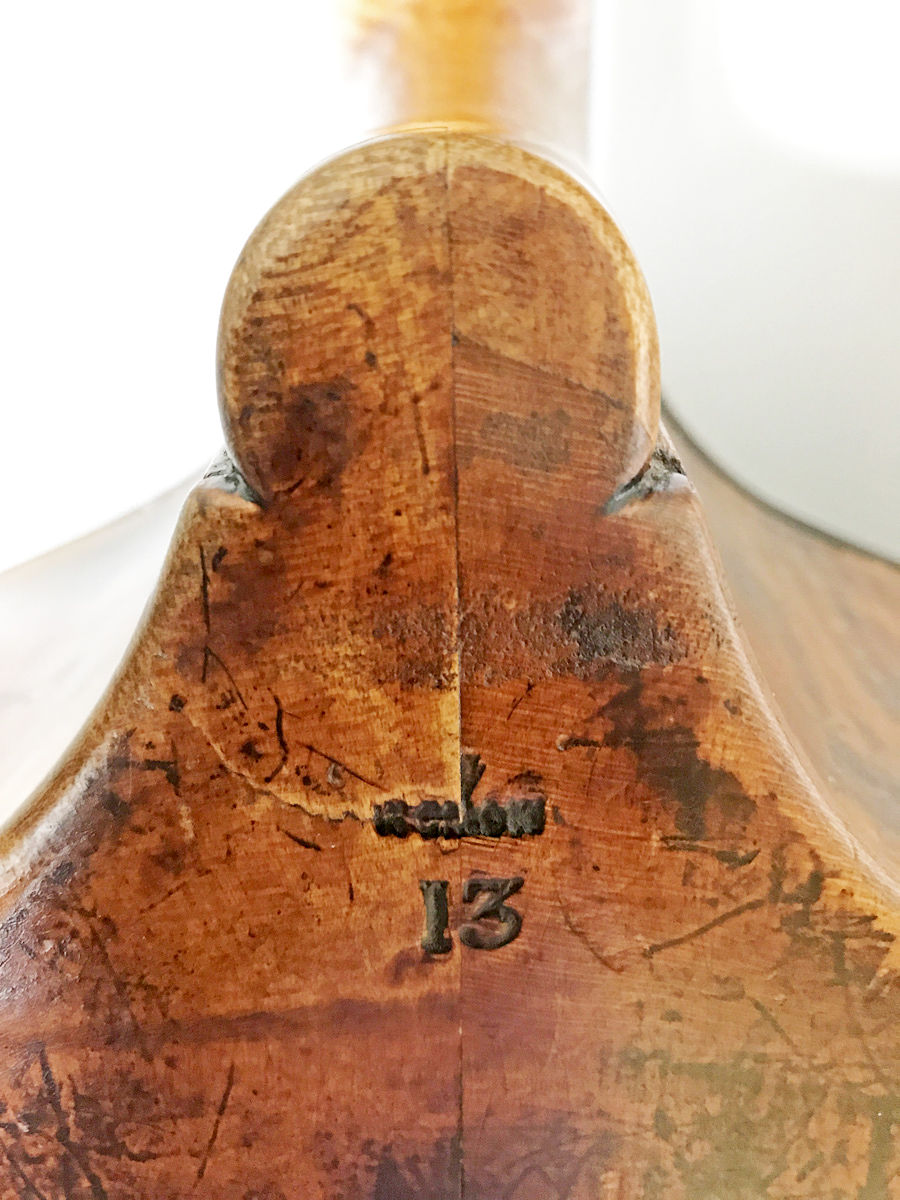.jpg)
William Howarth (1862-1935) was born in Kings Cross, Halifax in Yorkshire. Where he spent his early life is unclear but by 1886 he was living in Newton Heath, Manchester where he married and started a large family. The 1891 Census describe William as a Pattern Maker and in 1901, a Wood Pattern Maker. This was a very skilled job and his knowledge of tools and materials would have been high. Between these two dates Howarth made double basses. Where he learned the craft is unknown but the instruments are beautifully made and, as became apparent later, he could play them too. By 1911 his profession is listed as "Bandsman". This could have been a military title or simply, a musician. Interestingly his eldest son, Herbert, is also listed with the same profession. We next meet William Howarth in 1919 on the label of an instrument made in the area of Longsight, Manchester. Professional directories of this period list him as a Musician and he appears to have stayed in this area until his death in 1935. This particular bass was made in 1899. It is a fine orchestral instrument in excellent condition. It has acquired an extra coat of varnish but in all other respects is completely original.
Length of String 106.6cm
£75,000




.jpg)
James Brown (1804 - 1885) lived and worked in Huddersfield, Yorkshire from the mid 1850s amd made this double bass in 1862 as is clearly stated on it's label. It was originally built with a long body but in 1965 double bass player and instrument maker Robert "Bob" Norris reduced the shoulders of the bass giving it a very manageable short scale length. A photograph of the bass in it's original form can be seen in Raymond Elgar's famous book, "Looking At The Double Bass".
This instrument has been played all over the world in major London orchestras and is very reasonably priced for sale.
String Length 99.5cm. Length of Back 113cm.
£59,000




.jpg)
This bass by William Calow (1847 - 1910) was made in approximately 1885 in Nottingham. It is distinctive in it's shape, the Guaneri style f-holes and the makers brand, W.CALOW on the exterior back below the neck over the number 13.
Some restoration work was carried out to the edges of the front plus some interior work in 1988. I assume that at this time a thin extra layer of varnish was applied to the front to even out the colour for some reason. Other than that the bass is in a remarkable original condition.
This instrument is long but not particularly deep so easy to get around, and the sound is big and resonant.
Length of Back 119cm. String Length 109cm.
This double bass is currently under offer.




.jpg)
This fascinating instrument by William Booth of Leeds (1779-1858) has an interesting history. In the early 19th Century an amateur cellist named Barraud developed an instrument designed to be tuned as a cello but an octave lower so as to play the double bass parts in chamber music. He commissioned various luthiers including Thomas Kennedy and Samuel Gilkes to make such an instrument which became known as a Basso di Camera. The instrument featured is beautifully made and is inscribed inside with the following:
This Chamber Double Bass
Made by Wm. Booth. Mill Hill, Leeds.
In the year of our Lord 1821
for Dr. Hay of Cambridge
being the 3rd that has been known
to be made in this country.
The current owner decided that a three string configuration suited them better but all four string fittings
accompany the chamber bass, as does a 1946 William A. Chanot certificate.
String length 72.5cm. Length of Back 80cm.
£30,000.





Another example of the very fine copies of a bass by Bernard Simon Fendt. These were made for Thomas Martin in the 1970s to supply to his students and to fill a gap in the market of an affordable instrument that could be used in professional orchestras. I have found that they can vary in sound quality and colour of varnish. This bass is a particularly splendid on both counts and, of course, now benefits from nearly 50 years of regular playing by the previous owner who bought it new as a Martin student and used it throughout their career.
The original Fendt was owned by London Symphony Orchestra member, Robin McGee who was also a founder member of the London Sinfonietta and a Professor at the Royal Academy of Music. The instrument is now owned by the LSO.
This bass is labelled. It is numbered and dated
No. 39 in the year 1977
Length of Back 114cm. String Length 105cm.
This bass is now sold.





This very interesting bass was posing alot of questions to begin with. French? Probably but not typically. Age? Hard to say. And then the fascinating scroll. All became clear on discovering a name on the bass bar.
This reads M. Bruyas A St Etienne.
Maurice Bruyas was born in 1907 in the French region of Chaumont-sur-Loire. He was a violinist and secured work with the Radio and Opera Orchestras in Algiers. He also became a wood carver in some capacity and learned violin making from his uncle, an amateur luthier. He was obviously gifted as, by 1946, he had settled in St. Etienne where he was appointed luthier to the Conservatoire and, in 1949, won a diploma in a violin making competition at The Hague.
All this information leads to a double bass that is the perfect combination of Bruyas' wood carving and instrument making skills, c.1950. The rich sound and sloping shoulders of this well preserved instrument would make it an excellent solo bass, but would sound well in any situation.
Length of Back 118cm. String Length 106cm.
£15,000




.jpg)
This very good example of a Hawkes Professor double bass manufactured in the early 20th century unfortunately does not have a label. Despite this the model is well established and clearly recognisable.
These flat back instruments were made to Hawkes and Son's specifications to an English design, often in Germany to increase production. However they are considered English basses and provide an excellent way into the standard of instrument required to play in professional orchestras. They are also favoured by some jazz players.
At some point a decision was made to apply an extra coat of varnish to the front and back presumably to even out worn areas of the original varnish. Overall the instrument is in excellent condition and has a full even sound in all registers.
Length of Back 114cm. String Length 107cm,
£14,000








